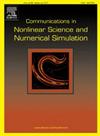黏度对胞浆进入微管及精确溶液的非线性动力学影响
IF 3.4
2区 数学
Q1 MATHEMATICS, APPLIED
Communications in Nonlinear Science and Numerical Simulation
Pub Date : 2025-01-17
DOI:10.1016/j.cnsns.2025.108615
引用次数: 0
摘要
细胞质溶胶的粘度在微管的生物学中起着至关重要的作用,影响着微管的结构和动力学功能。理解这个参数的整体功能是至关重要的。在建立纵位移和角位移模型时,研究了粘度对MT动力学的影响。利用旋转波近似分别导出了纵向位移和角位移的两个不耦合复金兹堡-朗道(CGL)方程。然后,利用改进的Hirota双线性方法构造了解析的两种孤波解类型。黏度似乎通过显著降低纵波的震级来抑制mt的纵向位移。在角位移的情况下,粘度的影响可以忽略不计,因此MTs的角位移对粘度是透明的。我们的分析预测得到了数值解的证实,准确度相当高。所获得的溶液在调节细胞质溶胶粘度以控制mt的组装、拆卸和稳定性方面具有广阔的应用前景。本文章由计算机程序翻译,如有差异,请以英文原文为准。
Nonlinear dynamics effect of viscosity of cytosol into the microtubules and exact solutions
The viscosity of the cytosol plays a crucial role in the biology of microtubules (MTs), affecting their architecture and dynamics function. Understanding the overall functionality of this parameter is essential. The effect of viscosity on MT dynamics is studied when modelling longitudinal and angular displacements. The rotating wave approximation is used to derive two uncoupled complex Ginzburg–Landau (CGL) equations for the longitudinal and angular displacements, respectively. Then, analytical two solitary wave solution types are constructed using the modified Hirota bilinear method. Its appears that the viscosity dampens the longitudinal displacements of MTs by significantly reducing the magnitude of longitudinal waves. In the case of angular displacements, the influence of viscosity is negligible, such that MTs angular displacements are transparent to viscosity. Our analytical predictions are confirmed by numerical solutions with pretty much high accuracy. The solutions obtained offer promising prospects for regulating the viscosity of the cytosol in order to control the assembly, disassembly and stability of MTs.
求助全文
通过发布文献求助,成功后即可免费获取论文全文。
去求助
来源期刊

Communications in Nonlinear Science and Numerical Simulation
MATHEMATICS, APPLIED-MATHEMATICS, INTERDISCIPLINARY APPLICATIONS
CiteScore
6.80
自引率
7.70%
发文量
378
审稿时长
78 days
期刊介绍:
The journal publishes original research findings on experimental observation, mathematical modeling, theoretical analysis and numerical simulation, for more accurate description, better prediction or novel application, of nonlinear phenomena in science and engineering. It offers a venue for researchers to make rapid exchange of ideas and techniques in nonlinear science and complexity.
The submission of manuscripts with cross-disciplinary approaches in nonlinear science and complexity is particularly encouraged.
Topics of interest:
Nonlinear differential or delay equations, Lie group analysis and asymptotic methods, Discontinuous systems, Fractals, Fractional calculus and dynamics, Nonlinear effects in quantum mechanics, Nonlinear stochastic processes, Experimental nonlinear science, Time-series and signal analysis, Computational methods and simulations in nonlinear science and engineering, Control of dynamical systems, Synchronization, Lyapunov analysis, High-dimensional chaos and turbulence, Chaos in Hamiltonian systems, Integrable systems and solitons, Collective behavior in many-body systems, Biological physics and networks, Nonlinear mechanical systems, Complex systems and complexity.
No length limitation for contributions is set, but only concisely written manuscripts are published. Brief papers are published on the basis of Rapid Communications. Discussions of previously published papers are welcome.
 求助内容:
求助内容: 应助结果提醒方式:
应助结果提醒方式:


